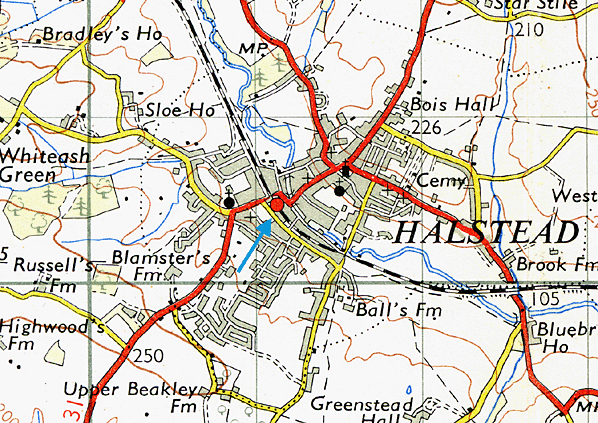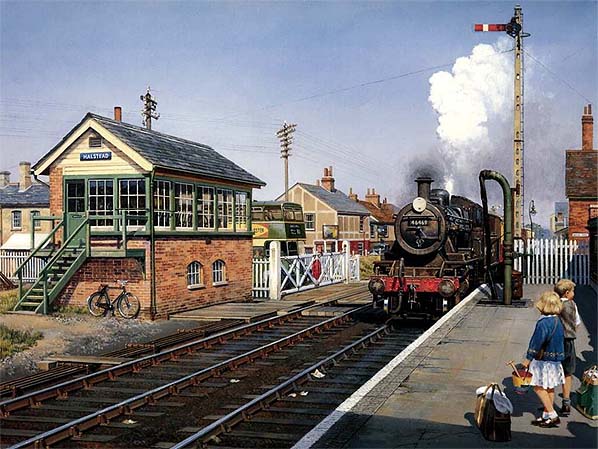|
BRIEF HISTORY OF THE COLNE
VALLEY & HALSTEAD RAILWAY
 |
An Act of Parliament of 30th June 1856 authorised the Colne
Valley and Halstead Railway to build a line from the Eastern
Counties Railway at Chappel & Wakes Colne to Halstead. The
company found it difficult to raise the required capital and
it was a further two years before construction started.
Before the line could be completed, there was a dispute with
the Eastern Counties Railway about the siting of the junction
at Chappel. At one point the CV & HR threatened to build
their own station close to the Eastern Counties station. The
dispute was resolved and the six mile line opened on
16th April 1860 |
By the time the line opened the company had obtained powers
for a 13 mile extension to Haverhill and work started on 19th
June 1860. The extension was opened in stages, to Sible and
Castle Hedingham on 1st July 1861, to Yeldham on 26th May 1862
and finally to Haverhill on 10th May 1863. An additional station
at Birdbrook was added in 1863.
With the formation of the Great Eastern Railway in 1862 the
CV&HR retained its independence. In 1865 the GER opened
a line from Sudbury to Cambridge via Haverhill where a connecting
spur to the CV & HR was built.
From its opening, the CV&HR was in financial difficulties
which were made worse when the local press mounted a campaign
against the railway company. A receiver was appointed in 1874
and under his control new capital was raised which allowed the
company to purchase three locomotives in 1876. Up until that
date all rolling stock had been privately owned. By the turn
of the century the CV & HR was enjoying its first and last
period of prosperity.
Although close relations were maintained with the GER the CV
& HR remained completely independent, until it became part
of the London and North Eastern Railway in at the 1923.
Most CV & HR trains had been using the Great Eastern station
as connections were usually required with Stour Valley trains.
The old terminus had been relegated to a goods station with
occasional passenger trains before amalgamation with the LNER
made it redundant. The station became the first casualty was
the terminus at Haverhill lost its passenger service on 14th
July 1924 It remained in use as a goods station until 19th April
1965 and as a goods station it was renamed Haverhill South on
1st February 1925.
As with many rural lines, the popularity of the motor car hastened
the decline of the CV & HR after WW2 and the passenger service
was eventually withdrawn on 30 December 1961. Freight traffic
lasted until 19th April 1965 and the track was lifted the following
year. This was not the end of the line however. In 1973 two
railway enthusiasts put forward a proposal to rebuild a short
section of the railway to operate a steam service as a tourist
attraction. After several planning applications permission was
granted to relay one mile of the line west of Castle Hedingham.
The first steam locomotive came back to the line in August 1973
and the following year the Colne
Valley Railway Preservation Society was formed. Track laying
began the same year and a new station, Castle Hedingham was
built. At that time the original Sible and Castle Hedingham
station was derelict and awaiting demolition. The owners agreed
to donate the building to the Society on the condition that
it was dismantled and cleared from the site within six weeks.
The building was dismantled brick by brick and it took a further
two years to rebuild, but externally it appears exactly as it
did when first built in 1861.
To see the other
stations on the Colne Valley & Halstead Railway click on
the station name: White
Colne, Earls Colne,
Sible
& Castle Hedingham, Castle
Hedingham, Yeldham,
Whitley, Birdbrook
& Haverhill
See also: Stour
Valley Railway
Long Melford - Bury St.
Edmunds Branch Line
Saffron Walden
Branch Line |



 Home Page
Home Page 


 Home Page
Home Page